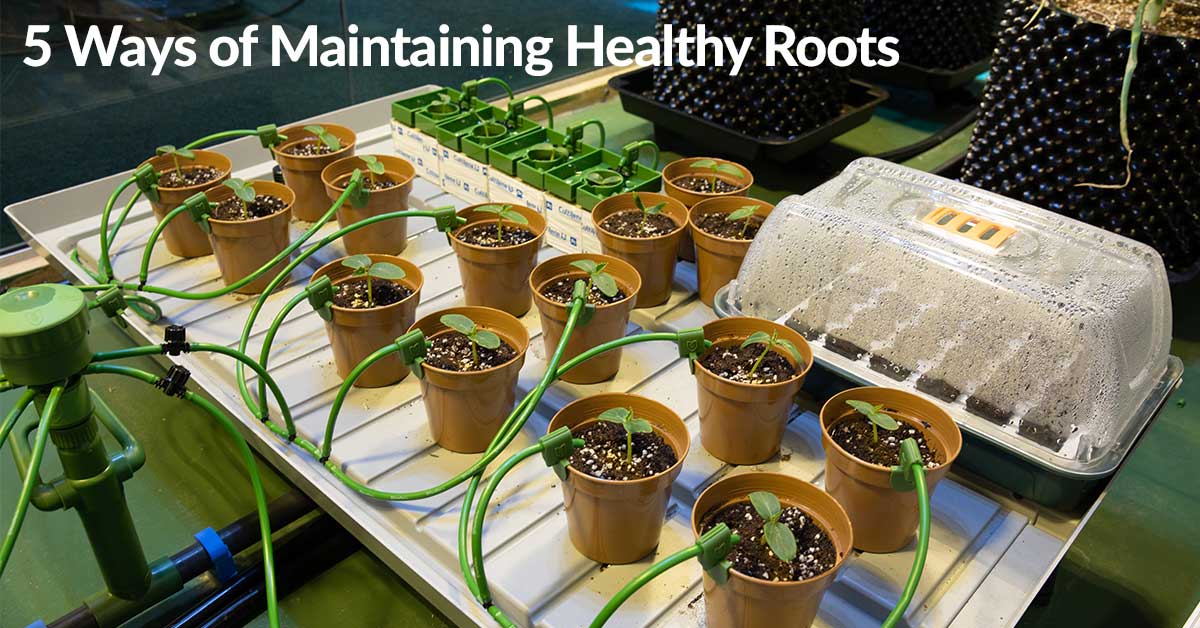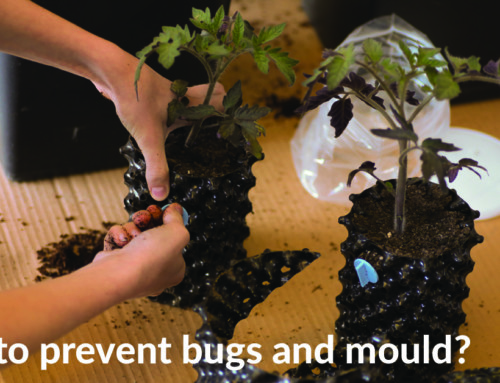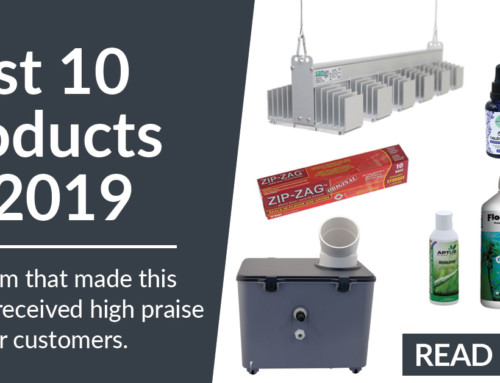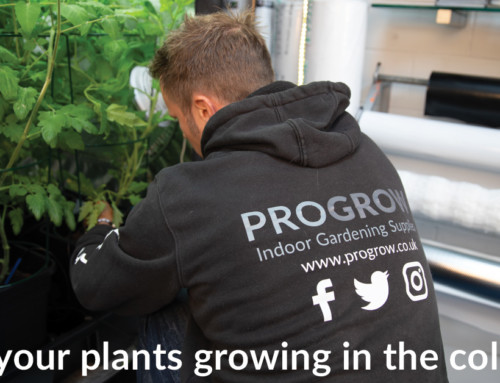Healthy roots mean healthy plants, as growers we are focused on what our plants are doing above ground. This is all very well and although in the natural environment plants derive nutrients and water through their leaves as well as the roots, in an indoor grow room foliar feeding is not always easy. In an indoor grow room the roots are the main site where nutrient and water uptake occur via osmosis. Good maintenance of your root zone is essential for optimum plant growth. Many problems that occur when growing indoors will be as a result of an imbalance within your root-zone and can usually be identified by characteristics in the plant itself.
There are several problems that come from compromised/damaged root systems:
1.Over/Under watering.
Too much water within the root zone will effectively drown the plant above, you will see lower leaves droop and yellow, the plant very much looks like it is drowning, this is because Oxygen is vital to the root zone and health of the plant. Over watering typically occurs in soil, Hydroponic users don’t tend to experience this, that said you should be careful not to over water when plants are first introduced to a NFT, DWC, Autopot, Ebb and flood or dripper system. A bedding in process is usual whereby the small plants are allowed time to grow root into the substrate. This may mean daily watering’s initially gradually upping the frequency of watering’s to normal, whether that be continual Nutrient Film Technique flow or drippers emitting nutrient solution hourly.
Too little water will again result in wilting/drooping of the plants leaves but tends to affect all of the plant. The leaves will start to shrivel, yellow, dry and die. Once the roots completely dry out there is very little time to salvage the plant especially if it is a fully grown one, this is particularly true for Aeroponic systems where plants are relying on regular misting of the rhizosphere.
What can be done?
If a plant has been over watered, then don’t feed/water it again until the excess water has fully drained out or been used by the plant. For Soil growers a good tip is to actually pick the pot up when it is fully watered, make a mental note of how heavy it is, if you pick the pot up the next day and little has changed then your plants will not need watering. You should wait until pots or soil are significantly lighter, as stated this is particularly true for young plants recently ‘potted up’. Over watering in a Hydroponic system is simply corrected by altering the frequency of watering’s.
If a plant has been under watered…. then water it! If you come in and find your plant in a slump with wilted leaves and the soil bone dry, then you need to get some water to them asap. Be careful not to deluge the plant as this can lead to over watering straight away and then you must correct that problem as well. So, water the plant little amounts at a time until adequate saturation is established and see how it responds. Be kind to plants that may have suffered in this way, back the lights away so you are not forcing them into excessive transpiration.
2. Imbalance in pH
The pH of your substrate/medium has a direct result of what nutrients can be absorbed. There is a small window within the pH scale where your plant will optimally absorb all elements without imbalances. It varies slightly depending on your substrate/medium but in general you want to be between 5.5 and 6.5 and up to pH7 in organic substrate such as coco. If you fall outside of this sweet spot you will encounter problems. Extremely high and low PH will start to affect the uptake of certain elements resulting in deficiencies or over feeding of certain elements.
What can be done?
Check the pH of your nutrient solution regularly and if you can, test any ‘run-off’ you may have as this can give you a great indication of what’s happening at the root zone. Either invest in a pH test kit or a Bluelab pH pen, the pH test kits are fail-safe, as will be a pH meter if it is well cared for and regularly calibrated with Buffers.
3. Root-bound
Traditional pot growing with soil can lead to plants becoming root bound, it can be caused by there simply not being enough space for the roots left to grow into, or it can happen when tap roots are seeking out nutrient elements not readily available.
What can be done?
If you grow in conventional pots, pot your plants up in stages to give them the best opportunity for roots to develop in the growing substrate. Make sure the pot you choose to grow your plants to maturity are big enough to support the size of plants you intend to grow. Ensure plants are consistently and well fed in soil, this will negate roots ‘searching out’ elements and strangulating.
Being Progrow we must also mention the excellent Air-pots and how their design (air pruning the roots) negates this problem entirely.
4. Pythium/Root-rot
The bane of all hydroponic growers…unfortunately if it is not identified and treated immediately its pretty much a death sentence for your plant. It is most likely to happen from roots sitting in poorly oxygenated, stagnant water that has exceeded 20 degrees Celsius. Hydroponic systems like DWC and NFT are more likely to suffer with this in the summer due to the ambient temperature being higher and without a water chiller will be unable to maintain a safe water temperature.
Pythium is a water mould so keeping your hydroponic systems cleaned and sterile is essential. The plastics of hydroponic systems can have micro scratches that be a hiding place for Pythium. In substrates root rot can also occur. It is more likely to happen in poorly draining media where temperature fluctuations occur. The biggest sign of root rot will be the smell…. if your roots have gone slimy, brown and stink….then I’m afraid you have root rot!
What can be done?
Sterilize your plastics, syringes, pH & EC meters after every crop with Hydrogen peroxide. The last thing you need is transference from one system/grow to the next. If you are unsure then bin the lot and buy new. I know that sounds extreme, but it will be the cheaper option compared to multiple failed crop after crop. Products like Regen-a-root and Wilt Guard can help in the first instance protect against this type of rot and secondly also help plants recover from such diseases. Mycorrhizal products like Orca and Great White shark can also help maintain the balance of beneficial bacteria and prevent root-rot occurring.
Water temperature plays a vital role in oxygen saturation within your water tanks. The higher the water temperature the less oxygen the water can contain. The sweet spot is between 16 and 18 degrees, higher than 20c and water loses its ability to hold oxygen. Chillers are a perfect solution for maintaining a stable water temperature.
Water movement is also essential, and can help maintain oxygen levels in the nutrient solution. Air-stones and Bubblegen are the two most popular methods of oxygenating and moving the water so it does not stagnate. Air pumps have the disadvantage of making a buzzing so if space permits it we recommend a Bubblegen which runs silent and connects to a water pump to circulate the water as well.
5. Fungus gnats
The larvae of these little black fly’s can cause big problems. The Adult fungus gnat lays the eggs of its larvae into the top part of the soil, the larvae then set about digesting your roots. If you see any flying black insects around the base of your plant, (particularly when you are watering) then they need to be eradicated fast.
What can be done?
Sticky traps around the plant pots will deal with the adult flies, to treat the larvae use a root drench such as Tanlin which is incredibly effective at eradicating the larvae in the substrate.
These are some of the main things to look out for whilst trying to maintain a healthy root-zone. Keeping your grow room clean, paying attention to watering cycles, pH & EC levels and checking for pests and diseases regularly should keep you in good stead. Attention to detail goes a long way and the sooner you identify a problem and treat it…the healthier your plant will be.





Leave A Comment